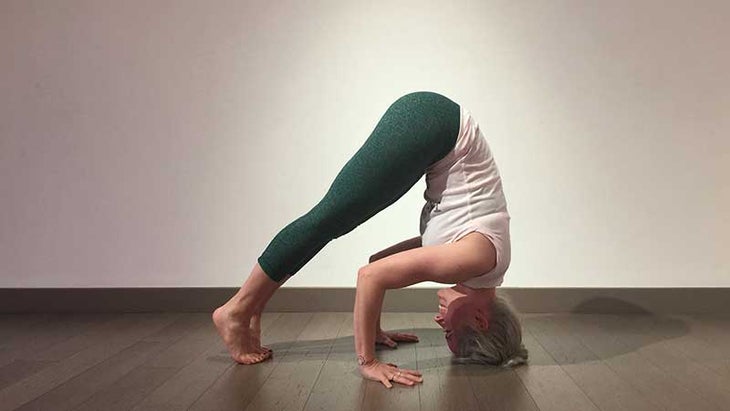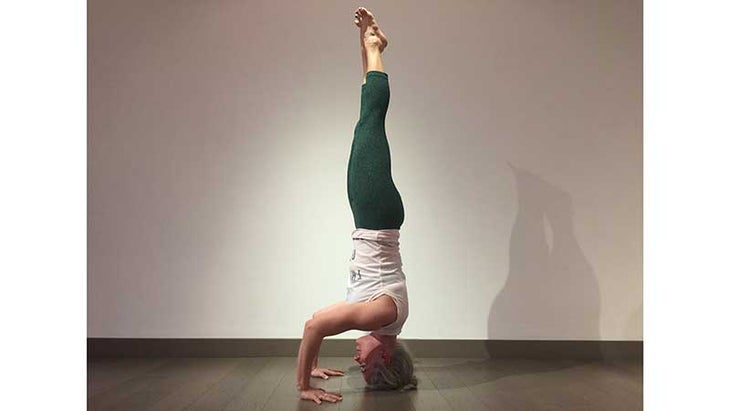Heading out the door? Read this article on the new Outside+ app available now on iOS devices for members! Download the app.
Once you make friends with Tripod Headstand a whole family of poses and transitions will emerge. Master this key pose first.
I recently had the honor and privilege to practice with two of my favorite Anusara brothers—Noah Maze and Darren Rhodes. They were teaching a weekend intensive at Yogaglo in Santa Monica and their Saturday afternoon focus was hand balancing. Take a Google break to look these yogis up if you don’t know them, then report back. These men are absolutely amazing. Two of the biggest hearts and most talented asana practices I’ve ever seen. I’ve been practicing with Noah for years now and he has the most uncanny ability to make me laugh and want to cry at the same time—think 3 minute Handstand holds followed by Hanumanasana x 10—yet I smile all the while.
Okay, Google/Facebook break over. Let’s return to the subject on hand: their hand-balancing workshop. These graceful yogis taught us multiple arm balances and put the 3rd series Ashtanga spin on it—all entered from Tripod Headstand. This leads us to another YouTube worthy moment. If you’ve never seen a 3rd series practitioner, do so before you die. It is one of the most beautiful practices to grace a mat. It’s as if the yogi never even touches the mat but rather skims the surface of reality woven in with fairy dust, imagination, sweat, and discipline. It made me realize how important this pose is and that I wanted to share it with everyone as a foundation for our challenge practice. Once you make friends with Tripod Headstand a whole family will emerge. Enjoy the barbecue of possibilities with your new posse and look out in the near future for poses building from this lovely pose.
Step 1: Get your floaties on

Begin in Plank Pose. Shoulders are stacked directly above the wrists and the shoulders, hips and heels are all in one even line. Find a small thrust in your pelvis lifting the frontal hip points up. Think of ‘connecting the dots’–top part of the pelvis lifting towards the bottom base of the ribs. This action engages the core, elongates the lower back and takes excessive weight out of the shoulders. Keep the gaze forward and the body in one solid line as the elbows bend to a ninety degree angle. Elbows remain over wrists, heart extends forward, elbows hug tight to the ribs. Take one full breath and either lower to belly or press back up to Plank and Down Dog.
Step 2: Test the water with Dolphin Pose

Come onto the knees and place the palms flat on the ground shoulder width apart. Bend the elbows placing the crown of the head onto the ground. (Not sure where that is? Take a yoga block and balance it on your head remaining even on all sides of your neck. That little point of balance is the crown). Make sure that the hands are far enough away from the face to create Chaturanga arms–elbows over wrists, full ninety degree angle in elbows. Curl the toes under, lift the hips up and straighten the legs to lift into Dolphin. Walk the toes in towards the head keeping the shoulders lifting to prevent any extra pressure on the head or neck. Keep the elbows in tight and a gentle push into the palms to aid in the support of the shoulders. Take 8 breaths and rest in Child’s Pose.
or. . . .

Once you’ve walked the feet in to shorten the stance of your Dolphin Pose, pick up the right leg bending the knee and place it lightly on the right triceps. Bend and place the left knee on the left triceps as well so you’re in a small perch. Instead of letting the weight bear down on your arms, keep the triceps engaged by pushing them into the knees to resist the weight. This will help you keep the shoulders lifted as well. Hold for 8 breaths and come into Child’s Pose or enter in to the final pose. . .
Step 3: Take the tail up!

Lift the hips up as the thighs draw tight to the chest. Stay compact as possible to help your center of gravity. Every few breaths remind yourself to lift the shoulders and keep the elbows in. Once the hips stack over the shoulders, the weight of the legs will lessen and the core will connect. Hook through the lower belly to lightly pull the knees off the arms into a pike position in your chest. Keep the inner heels and big toes touching as the legs draw up towards the ceiling as if being sucked through a straw. Hug the inner thighs to the midline, expand through the backs of the knee caps and spread the toes. From here you can reverse the process back into Child’s Pose or flex the feet, keep the body strong like plank and drop into Chaturanga.
Kathryn Budig is a Yogi, Yoga Teacher, Writer, philanthropist, Huffington Post, Elephant Journal, MindBodyGreen + Yoga Journal blogger, Foodie and lover of her dog. Follower her on Twitter and Facebook or on her site.